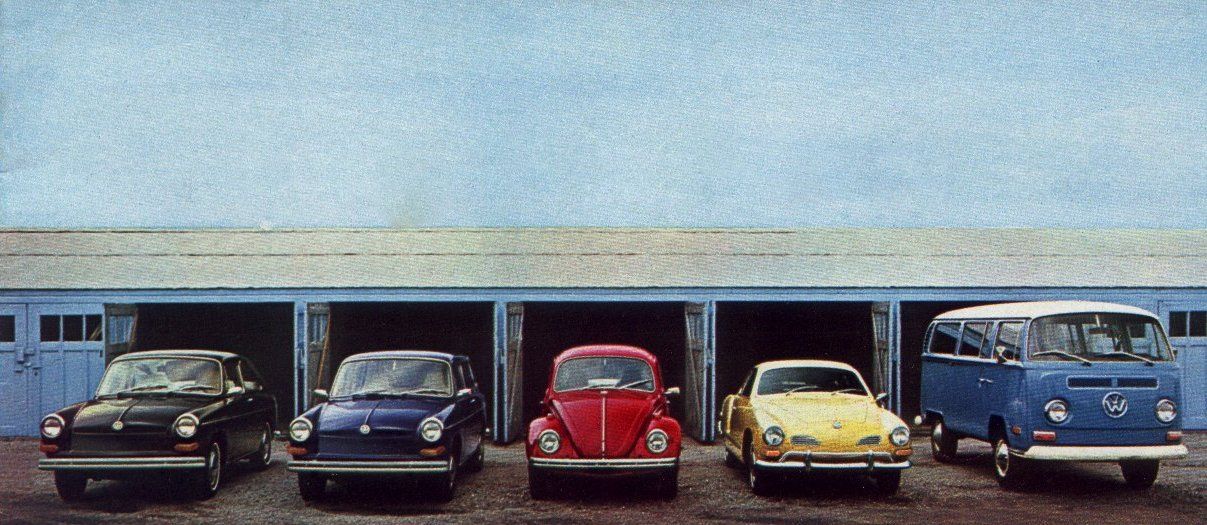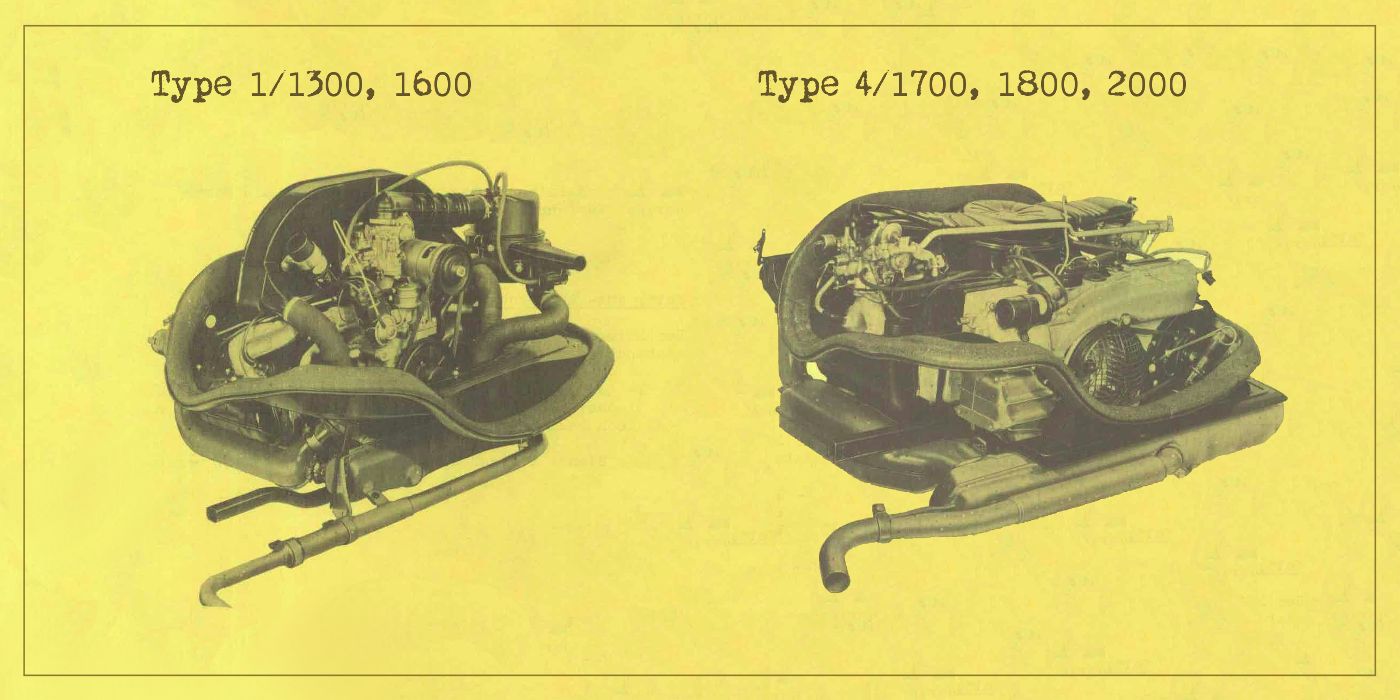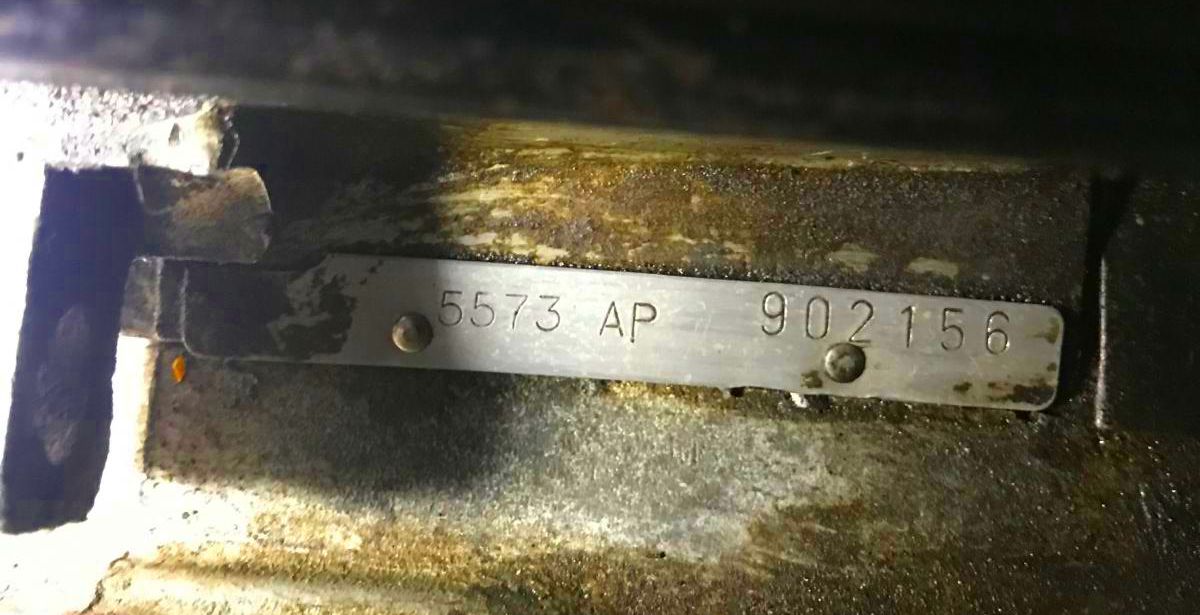Volkswagen bus engine codes

All engines in Volkswagen Type 2 busses from 1968 to 1979 were stamped with a serial number, including a two-letter code. Here's a vintage bus owner's guide on how to decypher the engine code.
Quick links
- ⏩ Take me to the engine codes list
- ℹ️ Why do I need the engine code?
- ℹ️ Where do I find the engine code?
- ℹ️ How do I read the engine code?
Engine types

Volkswagen vehicles of the era were classified into platforms that described their type. Type 1 (Beetle) and Type 2 (Transporter) were two of the most popular ones.
The engine designations were the same as the platform names of the vehicles they were first introduced in. However, there weren't Type 2 or Type 3 engines as such. Those vehicles did not feature new engine designs when introduced and used the already available Type 1 and Type 4 engines.
| PLATFORM | DESCRIPTION | ENGINE |
|---|---|---|
| Type 1 | Beetle | Type 1 |
| Type 14, Type 34 | Karmann Ghia | Type 1 |
| Type 2 | Transporter | Type 1 (early bus), Type 4 (late bus) |
| Type 3 | 1500/1600 | Type 1 |
| Type 4 | 411/412 | Type 4 |
Type 2 busses from 1968 to 1979 were powered by one of two kinds of engines depending on the production date (and destination): the Type 1 and Type 4 engines.

Type 1 engine (a.k.a. upright): the original engine that was introduced with the VW Beetle, and thus inherited its type designation. Up to 50 BHP and 1.6l displacement. Fuel delivery was performed via a single carburetor.
Type 4 engine (a.k.a. flat): first introduced with the Type 4 model and also inheriting its name, this bigger (and flatter) engine was provided more power and higher displacements with up to 70 bhp in 1.7, 1.8 and 2.0 litre configurations. Fuel delivery was initially performed with double carburetors, and starting with model year '75 in selected markets via Bosch's L-Jetronic fuel injection. Also used in the Porsche 914, the Porsche 912E and the first generation of (aircooled) Vanagons.
Within each class of engine there were multiple variations: displacement, fuel induction system, and automatic vs. manual transmission, to name a few.
Engine codes
Quick reference
This overview can be used as a quick reference for bus engines. For more details and compatible engines in other vehicles, see the full tables below.
| LTR | CODE | BHP | ENGINE | REMARKS |
|---|---|---|---|---|
| 1.6 | B, C, AD, AF, AS | 44, 46, 47, 50 | Type 1 | |
| 1.7 | CA, CB, CD, CE | 62, 66 | Type 4 | |
| 1.8 | AP, AW, ED | 68 | Type 4 | AP, AW carbureted; ED fuel-injected (USA) |
| 2.0 | CJ, GD, GE | 70 | Type 4 | CJ carbureted (mainly Europe); GD, GE fuel-injected (mainly USA) |
Early bus ('68 to '71)
| CODE | KW | BHP | LTR | FROM | TO | FUEL DELIVERY | ENGINE | COUNTRY | REMARKS |
|---|---|---|---|---|---|---|---|---|---|
| B0 | 35 | 47 | 1.6 | 08.67 | 07.70 | Single carburetor | Type 1 | Non-USA, USA/CDN | |
| B5 | 35 | 47 | 1.6 | 08.67 | 07.70 | Single carburetor | Type 1 | USA/CDN | M-code 1571 for the Americas |
| C | 32 | 44 | 1.6 | 08.67 | 07.70 | Single carburetor | Type 1 | Non-USA | Also known as C0 |
| AE | 37 | 50 | 1.6 | 08.70 | 10.72 | Single carburetor | Type 1 | USA/CDN | M-code 2402, 60 HP SAE gross |
| AD | 37 | 50 | 1.6 | 08.70 | 07.73 | Single carburetor | Type 1 | Non-USA | |
| AF | 34 | 46 | 1.6 | 08.70 | 07.79 | Single carburetor | Type 1 | Non-USA | M-code 2402 |
| AB | 32 | 44 | 1.3 | 01.71 | 07.73 | Single carburetor | Type 1 | Non-USA (Italy) | M-code 2523 |
Late bus ('72 to '79)
| CODE | KW | BHP | LTR | FROM | TO | FUEL DELIVERY | ENGINE | COUNTRY | REMARKS |
|---|---|---|---|---|---|---|---|---|---|
| CA | 49 | 66 | 1.7 | 08.71 | 07.73 | Dual carburetor | Type 4 | Non-USA | |
| CB | 49 | 66 | 1.7 | 08.71 | 12.73 | Dual carburetor | Type 4 | USA/CDN | |
| CD | 46 | 62 | 1.7 | 08.72 | 12.73 | Dual carburetor | Type 4 | USA/CDN | Automatic |
| CE | 46 | 62 | 1.7 | 08.72 | 07.73 | Dual carburetor | Type 4 | Non-USA | Automatic |
| AP | 50 | 68 | 1.8 | 08.73 | 07.75 | Dual carburetor | Type 4 | Non-USA | |
| AR | 32 | 44 | 1.3 | 08.73 | 07.75 | Single carburetor | Type 1 | Non-USA (Italy) | M-code 2523 |
| AS | 37 | 50 | 1.6 | 08.73 | 07.79 | Single carburetor | Type 1 | Non-USA | |
| AW | 50 | 68 | 1.8 | 11.73 | 07.74 | Dual carburetor | Type 4 | USA/CDN | |
| ED | 51 | 70 | 1.8 | 03.74 | 07.75 | FI L-Jetronic | Type 4 | USA/CDN, California | First bus fuel-injected engine on model year 74 for California. Model year 75 makes it standard for the rest of USA |
| GD | 51 | 70 | 2.0 | 08.75 | 06.77 | FI L-Jetronic | Type 4 | (USA/CDN), AUS, S | |
| CJ | 51 | 70 | 2.0 | 08.75 | 07.79 | Dual carburetor | Type 4 | Non-USA | The Type 4 engine is first introduced in Europe on model year '76, see TM-7 |
| GE | 51 | 70 | 2.0 | 08.76 | 07.79 | FI L-Jetronic | Type 4 | USA/CDN, AUS, S | M-code 2514. Introduced hydraulic lifters for all model years and air/fuel ratio closed-loop control for '79 California models5. Model year 79 had square exhaust ports6. |
Other models
Other VW and Porsche models featured the same Type 1 and Type 4 engines as buses, with some differences in the crankcase (e.g. location of oil dipstick) and fuel delivery (e.g. D-Jetronic vs. L-Jetronic). In some cases, these engines can either be adapted or used as a drop-in replacement in a bus.
Air-cooled Vanagon ('80 to '83)
| CODE | KW | BHP | LTR | FROM | TO | FUEL DELIVERY | ENGINE | COUNTRY | REMARKS |
|---|---|---|---|---|---|---|---|---|---|
| CU | 51 | 70 | 2.0 | 05.79 | 12.82 | Dual carburetor | Type 4 | Non-USA, S | Air-cooled Vanagon6 |
| CV | 51 | 70 | 2.0 | 05.79 | 12.82 | FI L-Jetronic | Type 4 | USA/CDN | Air-cooled Vanagon6 |
Type 4 ('68 to '74)
| CODE | KW | BHP | LTR | FROM | TO | FUEL DELIVERY | ENGINE | COUNTRY | REMARKS |
|---|---|---|---|---|---|---|---|---|---|
| V | 51 | 68 | 1.7 | 08.68 | 07.69 | FI D-Jetronic | Type 4 | Non-USA | --- |
| W | 60 | 80 | 1.7 | 08.69 | 07.73 | FI D-Jetronic | Type 4 | Non-USA | Shared case with Porsche 914 |
| Z | 51 | 68 | 1.7 | 08.69 | 07.73 | Dual carburetor | Type 4 | Non-USA | --- |
| AN | 63 | 85 | 1.8 | 08.73 | 07.74 | Dual carburetor | Type 4 | Non-USA | Shared case with Porsche 914 |
| AT | 56 | 75 | 1.8 | 08.73 | 07.74 | Dual carburetor | Type 4 | Non-USA | --- |
| EA | --- | 80 | 1.7 | ?? | ?? | FI D-Jetronic | Type 4 | USA | M-code 249, shared case with Porsche 914 |
| EB | --- | 72 | 1.7 | ?? | ?? | FI D-Jetronic | Type 4 | USA/California | Shared case with Porsche 914 |
Porsche 914 ('70 to '76)
| CODE | KW | BHP | LTR | FROM | TO | FUEL DELIVERY | ENGINE | COUNTRY | REMARKS |
|---|---|---|---|---|---|---|---|---|---|
| W | --- | 80 | 1.7 | 70 | 73 | FI D-Jetronic | Type 4 | --- | Shared case with Type 4 |
| EA | --- | 80 | 1.7 | 72 | 73 | FI D-Jetronic | Type 4 | --- | Shared case with Type 4 |
| EB | --- | 72 | 1.7 | 73 | 73 | FI D-Jetronic | Type 4 | USA-Cal | Shared case with Type 4 |
| GA | --- | 95 | 2.0 | 73 | 76 | ?? | Type 4 | USA | --- |
| GB | --- | 100 | 2.0 | 73 | 76 | ?? | Type 4 | Non-USA | --- |
| GC | --- | ?? | 2.0 | 73 | 76 | ?? | Type 4 | USA-Cal | --- |
| EC | --- | 76 | 1.8 | 74 | 76 | FI L-Jetronic | Type 4 | USA-Cal | --- |
| AN | --- | 85 | 1.8 | 74 | 75 | Dual carburetor | Type 4 | Non-USA | Shared case with Type 4 |
Porsche 912E ('75 to '76)
| CODE | KW | BHP | LTR | FROM | TO | FUEL DELIVERY | ENGINE | COUNTRY | REMARKS |
|---|---|---|---|---|---|---|---|---|---|
| * 406nnnn * | --- | ?? | 2.0 | 75 | 76 | FI L-Jetronic | Type 4 | USA | --- |
Beetle
TBD
Notes
- M-code 157: exhaust emission control for the US market. This code had different meanings depending on the engine and the model year. For instance, on the 1700 engine from Aug. '71 it meant turning off vacuum advance on 1st, 2nd and 3rd gear.
- M-code 240: engine with dished pistons (low compression) for countries with low octane (lower quality) fuel.
- M-code 252: smaller 1.3 l engine for Italy.
- M-code 252: 2.0 liter with 70 HP CJ/GD/GE instead of 1.6 liter motor with 50 HP (USA/CDN, S, AUS). The meaning change for the M code was from 1976 onwards.
- The GE engine was the first one with hydraulic lifters and a single oil relief system. Model years '77 and '78 featured cylinder heads with oval exhaust ports as their predecessors. Model year '79 introduced the one-year-only cylinder heads with square exhaust ports and the fuel-injected air/fuel ratio closed-loop control for buses sold in California, which had stricter emission regulations.
- 08.76 - GE 000 001 through GE 007 082 (7082 buses produced) most probably introduced in Sweden and Australia.
- 08.77 - GE 007 083 through GE 039 331 (32249 buses produced) introduced in US/CDN.
- 08.78 - GE 039 332 through GE 049 407 (10076 buses produced) cylinder heads with square exhaust ports, California fuel injection system introduced, along with continued production of the Federal fuel injection.
- Vanagon-style: square exhaust port heads (029 101 371 on Bay Window Bus, 071 101 371 on Vanagon), hydraulic lifters
ℹ️ Early bus engines are Type 1, single-carburetted
ℹ️ Late bus engines are Type 4 in the USA, Canada, Australia and Sweden; dual-carburetted or fuel-injected. In most of Europe and other countries, they are generally Type 4, dual-carburetted, with some Type 1 exceptions.
ℹ️ Late bus engines with carburettors have a fuel pump hole in the lower right case half, whereas fuel-injected ones do not. The hole can be blocked for a carburettor to fuel-injection conversion, but not the other way round.
ℹ️ The air-cooled Vanagons also featured engines with codes CT, CS and CZ. These were neither Type 1 nor Type 4 engines and never used on T2 buses, thus they are not on the list. They were a newly developed inline motor, which shared some similarities to its predecessors (oil filter, similar cooling, etc).
Why do I need the engine code?
Knowing the engine code is not strictly necessary. However, it can be quite helpful in a number of situations. For instance, here's what the engine code will tell you –
If you are buying a new motor:
- The displacement (unless a previous owner has modified it)
- The original fuel induction system and if it has been changed from the factory
- The original application: whether it came from a bus and which year, or from another vehicle (Beetle, 411, Porsche, Vanagon)
If you are replacing or installing a new motor:
- The mount options (for instance air-cooled Vanagon mounts are different)
- The EGR and fuel induction system compatibility with your bus (location of components, different engine tins, etc)
- Exhaust system compatibility (e.g. cylinder head exhaust port type vs heat exchangers)
If you are a new bus owner:
- A bit more about the history of the bus –whether the current engine matches the model year and serial number, and whether it's a factory or replacement engine
Ultimately the engine code is simply another tool to know better a particular motor and help taking more informed decisions about maintenance, prospective work, installation and purchase.
Where do I find the engine code?
Type 1 engine number location

Type 4 engine number location

How do I read the engine code?

The engine number takes the following form:
[R] CC SSS SSS [X] [V]
- R: optional "recycled" pictogram. Only present in replacement motors. See "X" below.
- CC: generally a two-letter code that identifies the engine generation. In some cases, it can also be a letter and a digit (e.g. B0, B5, H0, H5)
- SSS SSS: 6-digit sequential serial number, starting at 000001 for each two-letter engine code
- X: replacement engine. Optionally an X letter indicates that a particular engine has been rebuilt from VW and retrofitted in a bus, replacing the original factory engine. Remanufactured engines also featured a "recycle" pictogram preceding the two-letter code.
- V: optional VW dot logo
Engine code exceptions

💡 There is an exception to this scheme in the Porsche 912E engines: the engine number has no leading letters, it is instead a 7-digit number with an 8-pointed star pictogram on each side. The number always starts with 406 and the four subsequent digits are the sequential serial number of the 2099 Porsche 912E vehicles that were ever made. The earlier Porsche 914 engines followed the standard VW engine code scheme.
💡 Another exception can be found on replacement engine cases as opposed to complete replacement engines, whereby the original engine number would have been milled away and only the "recycle" pictogram and the two-letter engine code were stamped. That is, the original serial number was lost.

💡 Some aftermarket engine rebuilders replace the stock VW engine code with their own numbering scheme. An example is, reportedly, the Dutch engine remanufacturer VEGE, who replace the original code with a riveted plate and a custom code.
Sources
The engine code table has been collated from multiple sources. All codes previously scattered through multiple locations have been aggregated into the table for easy reference, regardless of the engine's export country.
- Engine code letters, from the Volkswagen Parts Service. Only US and Canada engine codes
- The Samba forum engine codes list. Mostly US engine codes
- Rolf-Stefan Badura's engine codes list. Mostly European engines.
- Motorkennzeichnungen für luftgekühlte VW-Motoren by Michael Knappmann. Includes all aircooled VW engine codes, not only those for the Type 2.
- VW Transporter and Microbus Specification Guide 1967-1979, by V. Molenaar and A. Prinz
- VAG vehicle codes. Some data regarding years of manufacture seems not to be accurate.
- Air-Cooled VW Engine Identification Letter I.D. Codes & Displacement Chart at volksbolts.com
- Bosch Classic Service
- How to rebuild your VW air-cooled engine, by Tom Wilson
- Reparaturleitfaden Typ 1, Typ 2 bis 6.79 - Instandhaltung genau genommen, by V.A.G. Service. Scanned by the late Michael Knappmann.